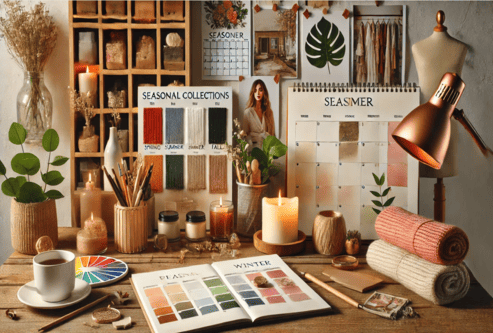As a handmade business owner, one of the best ways to maintain relevance and boost sales throughout the year is by creating and launching seasonal collections. These collections can help you connect emotionally with your audience, align your products with seasonal trends and events, and keep your offerings fresh and exciting. Seasonal planning isn’t just about timing—it’s a strategic approach to product development, marketing, and storytelling.
In this article, you’ll learn how to plan, design, and launch seasonal collections that drive engagement and increase revenue for your handmade business.
You might also like: Stylish Crafts: Sophisticated Ideas to Make Your Home Truly Unique
Why Seasonal Collections Matter
Seasonal collections create anticipation and urgency. Customers look forward to new releases that reflect the time of year, holidays, or special occasions. Whether it’s cozy fall candles, festive winter decorations, floral spring jewelry, or breezy summer scarves, aligning your products with the seasons helps:
Build excitement with limited-time offers
Create consistent reasons to promote your shop
Showcase creativity and relevance throughout the year
Increase sales during gift-giving seasons and holidays
1. Choose the Right Seasonal Themes
The first step in planning a successful seasonal collection is selecting themes that resonate with your brand and audience. While major holidays like Christmas, Valentine’s Day, and Mother’s Day are obvious choices, don’t overlook:
Seasonal moods: spring renewal, summer adventure, autumn coziness, winter stillness
Cultural and local events: fairs, festivals, seasonal markets
Lifestyle moments: back-to-school, wedding season, vacation time
Think about what your ideal customer experiences during these times and how your products can complement those moments.
2. Create a Seasonal Calendar
A seasonal calendar is your roadmap for the entire year. It helps you plan product development, marketing campaigns, and restocks in advance.
Break the year into four main seasons (Spring, Summer, Fall, Winter), and within each, list: Major holidays
Product launch windows
Marketing campaign periods
Craft fair or market dates
Give yourself at least 1-2 months of lead time before each launch to design, produce, photograph, and promote your seasonal items.
You might also like: Stylish Crafts: Sophisticated Ideas to Make Your Home Truly Unique
3. Design Products That Fit the Season
Once your themes and calendar are in place, it’s time to design seasonal products. Consider how your existing product line can be adapted with seasonal touches.
Ideas for seasonal customization: Color changes – use seasonal palettes (e.g., pastels for spring, warm tones for fall)
New materials – lightweight fabrics in summer, cozy textures in winter
Limited-edition scents or flavors – lavender in spring, cinnamon in autumn
Holiday-specific packaging or tags
Personalized gift sets for special occasions
For example, if you sell handmade candles, you could launch a winter collection featuring scents like pine, peppermint, and vanilla spice, paired with festive labels and metallic packaging.
4. Source Materials in Advance
Seasonal planning requires you to be proactive with inventory. Don’t wait until the last minute to order supplies, especially during busy holiday periods.
Make a list of all the materials you’ll need for each collection: Core materials (e.g., fabric, wax, beads)
Packaging supplies (boxes, tissue paper, labels)
Marketing materials (tags, thank-you cards, postcards)
Order samples early and buy in bulk where possible to reduce costs. If you work with custom or handmade suppliers, build strong relationships to ensure timely delivery.
5. Create a Cohesive Collection
Your seasonal products should feel like part of a well-thought-out collection. Whether you’re releasing five items or fifteen, they should share a common thread.
Ways to create a cohesive feel: Consistent color scheme
Similar design motifs
Unified packaging and branding
A shared theme or inspiration (e.g., “Cozy Nights” for fall or “Ocean Breeze” for summer)
Think of your collection like a mini world—it should tell a story and invite your customers to experience the season through your creativity.
6. Prepare Your Marketing Strategy Early
A successful seasonal collection needs an intentional marketing plan. Begin by teasing your new collection weeks before launch to build interest.
Marketing tips: Post behind-the-scenes content during product development
Use countdowns and “coming soon” posts on social media
Send email newsletters to your list with sneak peeks and early access
Collaborate with influencers or brand ambassadors for launch promotions
Create blog content around seasonal themes and how your products fit in
For major seasons like the holidays, consider offering early-bird sales, gift guides, or bundles to boost conversions.
7. Photograph Products with Seasonal Styling
Visuals are everything when it comes to seasonal collections. Your product photography should reflect the mood and setting of the season.
Tips for seasonal styling: Use props and backgrounds that match the theme (e.g., pumpkins for fall, flowers for spring)
Photograph items in seasonal settings—outdoors, near a fireplace, with festive decorations
Use consistent lighting and editing to keep your brand cohesive
Don’t forget to include both lifestyle and product-only images so customers can envision the product in their homes or as gifts.
8. Launch and Promote with Purpose
When it’s time to launch your collection, create a sense of excitement and urgency.
Ways to generate buzz: Host a virtual launch event or Instagram Live
Offer limited-time discounts or bonuses for early purchases
Use phrases like “limited edition,” “seasonal favorite,” or “available until…”
Create highlight reels or story pins featuring the new collection
Update your website homepage to reflect the seasonal collection
Plan your launch date carefully to align with customer shopping habits—for example, aim to release holiday collections in early November to capture gift buyers.
9. Track Performance and Get Feedback
After your collection goes live, monitor performance to learn what works and what can be improved.
Track: Top-selling items
Customer feedback and reviews
Inventory levels
Marketing engagement (clicks, likes, saves, shares)
Use this data to inform future seasonal collections. If a particular theme or product did well, consider bringing it back next year or expanding the line.
10. Repurpose and Retire Products Thoughtfully
Not all seasonal products will be evergreen, but that doesn’t mean they should go to waste.
Ideas for repurposing: Turn seasonal best-sellers into year-round versions
Bundle slow-moving items into clearance gift sets
Use leftover supplies to prototype next year’s collection
Archive collection images for seasonal social media content later
Stay organized by storing seasonal designs, mood boards, and notes so you can revisit and improve them in the future.
Conclusion
Planning seasonal collections is a creative and strategic way to keep your handmade business fresh, relevant, and profitable all year long. By aligning your products with customer needs and seasonal trends, you can create collections that not only sell well but also build anticipation and brand loyalty.
Start with a seasonal calendar, get inspired by the time of year, and let your creativity shine through every candle you pour, every bracelet you string, and every detail you design. Your customers will thank you—not just for the beautiful products, but for the thoughtful experience you’ve crafted around them.

